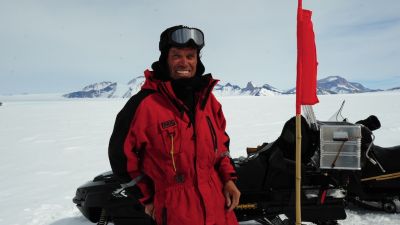
BELARE 2011-2012: Facing the challenge
As winter approaches, the last occupants of Belgium's Princess Elisabeth Antarctic Station have departed. Alain Hubert looks back on the BELARE 2011-12, one of the most challenging seasons faced by the team so far.
Our first hurdle was the awful meteorological conditions that awaited us when arriving at Utsteinen, the location of Princess Elisabeth station: we removed hundreds of tons of snow so that we could gain access to the garages and clear the solar panels. With scientists joining in earlier than usual in the season, all of our logistical equipment had to be operational from the outset.
Then there was the ten-day delay of our ship, the Mary Arctica, kept offshore by the thick sea ice. But thanks to the dedication and hard work of all team members, we managed to catch up on all of these lost days, so that all scientists present in the Princess Elisabeth area could complete their programs.
This season's difficulties were compounded because of operating with a very much reduced crew and a tight budget. As a benchmark, it is generally recognized that station operations in Antarctica work with a ratio of four to five technical staff members for every one scientist. this year at Princess Elisabeth this ratio was 1:1! This was a gigantic challenge, and in hindsight, I must admit that I will remain deeply impressed for a long time by the incredible amount of tasks carried out in such a short period of time by our small team of technicians and engineers.
A Complete Success
Even if the season was a hardship, it's important to realise that it was also a success. The presence of many foreign scientists has confirmed the international scope of Princess Elisabeth Antarctica. We had Belgian scientists of course, but also from Japan, USA, Germany, Norway, South Africa and France, including more than twelve universities and institutes. On top of this, we had observers (technical teams and journalists) visiting from Belgium, Switzerland, Canada, France, USA and Spain.
Then, I want to pinpoint once again the very professional behavior of our technical team (technicians, engineers and logistics staff). I take this opportunity to thank them all for their know-how, their flexibility, their energy as well as for their human touch and their warm welcome to visitors.
One of its kind in the world, Princess Elisabeth station keeps demonstrating its importance as a proven prototype to the international community; its energy production and management system continues drawing the attention of several industrial partners who consider it a perfect venue for developing new technologies related to energy efficiency. Such technologies will have to be implemented in our countries in the near future, to become an active part of the energy mix challenge and avoid the risk we all face of a global failure because of the ever rising costs of energy.
A New Path
This Antarctic season, you will have alsonoticed how we increased our communication flow by setting a closer follow-up of our activities, bringing a growing number of web visitors closer to the realities and facts of the rough polar life. We have also aimed to raise awareness about the importance of polar research and its paramount role in creating a better understanding of the future of our Planet.
I had a Dream
The dream was to launch a demonstration project that would motivate and draw scientists, engineers, industrialists and politicians into the endeavor… even though Princess Elisabeth station could have originally seemed utopian, I reckon. By being one of the twelve signatories of the Antarctic Treaty, hadn't Belgium committed to maintain research activities on the 6th Continent?
Today, I have the feeling that utopia is turning into reality. Beyond its scientific mission purpose, the clear and stated objective of Princess Elisabeth station was to aim at a zero impact on environment, thus addressing the 1992 Madrid Protocol that had substantiated the environmental content of the Treaty. The Princess Elisabeth station achieves this goal to perfection. Indeed, it proves that the future for energy production and management can be different from what we routinely use nowadays in our homes and workplaces. We must be creative and transfer such energy concepts into our society, thus building momentum for a new sustainable economic development.
I will close by thanking by name, the whole team all people who contributed to the success of this season: the Belgian government as it i responsible for funding the Belgian federal research and the corresponding infrastructure; the corporations and industries who consider PEA as an advanced demonstrator where to implement new technical developments; the greater public and specifically the young people who followed the season events through initiatives and actions inspired by the core concept of the station: Aiming for Zero Emission!
This all shows that our future can be different, that science has a fundamental role in understanding the complex environmental questions, and that change is possible as a carrier of new initiatives for the new generations.
Picture: Alain Hubert - © International Polar Foundation
